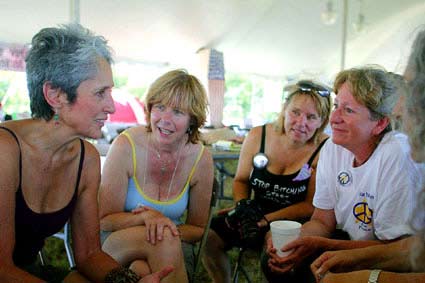George
Wallace
DEEP
IN THE HEART OF CRAWFORD ----(page
4)

7.
HOW MANY DEATHS WILL IT TAKE
Under the tent, the entertainment
has taken a serious turn. Cindy is not back yet, but major figures - congressmen,
commentators, celebrities - are showing up to add their voice of support to the
effort, to show that like America, they stand with Cindy.

Including Steve Earle, a gravel voiced Texas rocker who exudes folk history with
each strum of the guitar, sings 'The Revolution Starts Now,' electrifying the
audience.
I get
interviewed by Lois Lane, aka Margo Kidder reporting for a small newspaper in
Montana. I talk with independent photographers from LA to Spain. I meet a grandchild
of American poet Louis MacNeice. I help Jeff Keys - who has given a cathartic
90 minute monologue series of vignettes of Marine life in Iraq late one night
- adjust the oversized coffin which provides sober reminder of those who have
died there.
It
is all very communal and supportive and despite the harshness of the conditions
- each day heat prostration hits a couple of people, bug bites and sheer exhaustion
of exposure to the heat debilitates many) - congenial enough. But there is an
undercurrent of uneasiness running through the camp. Is that a secret service
guy? Did you hear that the cops were pulling out shotguns down at Tonkawa Park?
Would it be a bad thing to offer the counter-demonstrators some water?
I'm
writing notes, a young stud asks me who I'm writing for and if I have an id. The
next day, a man in khakis and a Brooks Brothers shirt interviews me, saying he's
from the Washington Post. Someone confronts him, asking for press ID, he flashes
something plastic and indistinct, and leaves off quickly.
And
there is the hardship. Heat prostration. People stop making sense or become somewhat
inarticulate. We sweat mightily. We get bitten up and unwashed.
I
tell someone I went swimming in the quarry. Oh there's water
moccasins in there,
he says blandly. Don't swim in there alone.
8.
THE ANSWER MY FRIEND

Click
The Pix To View "Last Night I Dreamt The Strangest Dream"
VidClip.
On Sunday Joan Baez arrives
on the scene with the resilience and beautiful serenity of a lifelong Quaker.
No resignation even at this stage of her life (her mother's parasailing at 92,
so who will stop Joan?). Joan Baez, a sunflower in a Texas field. She's been protesting
since she was a kid in the high school lunchroom. She was with Martin Luther King,
sang lullabies to him to lull him to troubled sleep. She was everywhere during
the Civil Rights movement and the anti-Vietnam movement. "I didn't think
this would happen again in my lifetime," she tells me.
Joan
Baez. She has got to be the only person on earth who can make Kumbaya sound good
in the 21st century - even without doing the uptempo version she learned from
some rural blacks when she first started singing it.

Click
The Pix To View "Swing Low, Sweet Chariot" VidClip.
A
legend, but a real person, she headlines one evening's entertainment, but doesn't
do the celebrity thing - soak up the limelight and then split - she stays day
after day, talking to people, sharing her experiences, supporting the moment.
Like me, holding down the fort until Cindy returns.
To
Ann Wright and the thousands who have come together under the tent at Camp Casey,
she says, "You give me hope." Back in her trailer afterwards she gives
me a hug. "Bring that back to the people in Woodstock and in New York,"
she says.
9.
THE BEST MONUMENT TO DISSENT
In all, I will stay here at camp
four days, and fly back just in time to learn that Cindy is on her way back to
Crawford. Though I haven't had a chance to shake her hand, something even more
important has been accomplished - I've helped keep her camp going and demonstrate
that her question to the president is decent and simple and is America's question.
America deserves more than spin and smear, it needs an adequate answer - what
noble cause are the soldiers dying for in Iraq?
I
don't know if Cindy Sheehan's stand in Crawford is a watershed moment for America
over the war, but the nation has finally been brought into sharp focus about the
issue, and its division over the issue as well. The dissent has begun in earnest,
and it sure feels like a historic moment for the nation. In fact someone has already
put up a temporary historical marker on the site of Camp Casey.
There
are not too many monuments to dissent in America. Where are the monuments to those
whose patriotism and sense of humanity and moral integrity led them to question
their government - in the labor movement, peace activist across several wars,
Spanish Civil War brigade volunteers.
After
Vietnam, Abbie Hoffman said 'this is the first time in history a people rose up
against its own army, said we don't want it, and made them stop.'
One
day there may be something here to permanently mark the spot where Cindy Sheehan
accomplished that for America. Until then, the best monument to dissent is the
justice and the liberty it brings to the people.
Next
Page . . .
